Are you a fan of Soba noodles and looking for an alternative dish? If so, you’ve come to the right place!
We understand that it can be difficult to find a suitable substitute for Soba noodles that allow you to maintain great taste and texture.
Fortunately, a few simple ingredients can be used in the place of regular Soba noodles; this blog post covers several options, along with some tips on how to make them.
Keep reading to learn more about delicious alternatives for Soba noodle dishes!
What Are Soba Noodles?
Soba noodles are thin, buckwheat flour-based noodles that originated in Japan and are a staple of Japanese cuisine.
They are typically served chilled with a dipping sauce but can also be served hot in soups or stir-fries.
Soba noodles offer an earthy flavor and chewy texture, making them a favorite among many.
They are high in carbohydrates but low in fat and calories, making them a healthier alternative to other noodles.
Soba noodles are used in various dishes, including stir-fries, soups, salads and cold noodle dishes.
Adding soba noodles to stir-fries at the end of cooking is best, as they can become soggy if overcooked.
They are also great in salads and cold noodles, served chilled or at room temperature.
In addition to being used in savory dishes, soba noodles can be used in sweet desserts such as mochi ice cream.

Substitutes For Soba Noodles
Several options are available if you want to substitute for soba noodles.
Udon Noodles
Udon noodles are a type of thick wheat flour noodle that originated in Japan.
They have a chewy texture and are often served in soups or stir-fries.
[display-posts id=”2280″ image_size=”thumbnail” posts_per_page=”1″]
Udon noodles can be made with either fresh or dried ingredients, depending on what kind of dish you’re preparing.
Udon is becoming increasingly popular as a substitute for soba noodles in many types of Japanese cooking.
This is largely due to their versatility, as udon can be used in various ways that traditional soba noodles cannot.
It can be boiled, fried, or served cold and are especially great for absorbing flavorings and sauces.
Udon noodles also tend to hold their shape better during cooking, making them ideal for stir-fries and cold salads.
Unlike soba noodles, udon can be stored in the refrigerator for up to a few days without losing its texture or flavor.
They are also relatively inexpensive and easy to find in most Asian grocery stores.
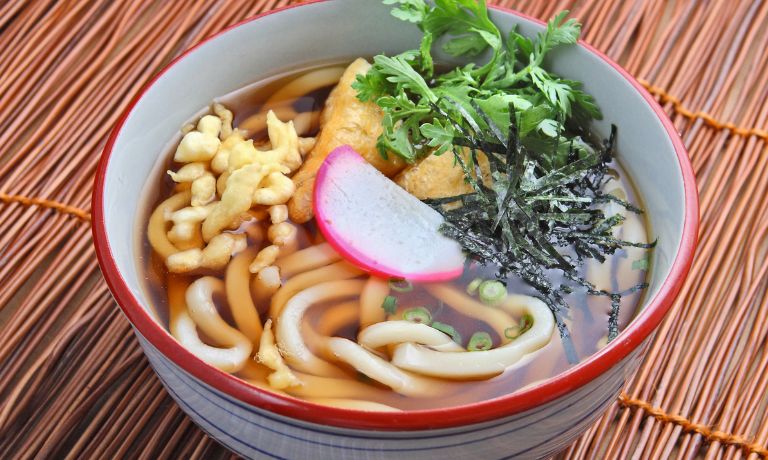
Ramen Noodles
Ramen noodles are a type of Japanese noodle made from wheat flour, salt, and water.
They are usually packaged with various flavors and toppings, such as vegetables, meat, seafood, and condiments.
Ramen noodles have become a popular substitute for soba noodles in cooking because they cook quickly, can be adapted to various dishes, and are widely available.
They are also much cheaper than soba noodles and can be found in most supermarkets.
Ramen noodles are typically served with broth made from dashi (Japanese fish or seaweed stock), soy sauce, and mirin (a sweet rice wine).
When choosing ramen noodles for your dish, you should look for noodles made from 100% wheat flour with a firm texture.
These types of ramen noodles will hold up better when cooked and provide a more authentic flavor.

Rice Noodles
Rice noodles, also known as “rice sticks” or “vermicelli”, are made from rice flour and water.
These noodles are popular in Chinese, Thai, Vietnamese, Malaysian, Indonesian and other Asian cuisines.
[display-posts id=”2273″ image_size=”thumbnail” posts_per_page=”1″]
Rice noodles come in various shapes and sizes and can be used to make soups, stir-fries, salads and spring rolls.
Rice noodles can be a great alternative to soba noodles in cooking because they have a similar texture and flavor profile.
Moreover, rice noodles cook faster than others, making them a convenient and time-saving option for busy home cooks.
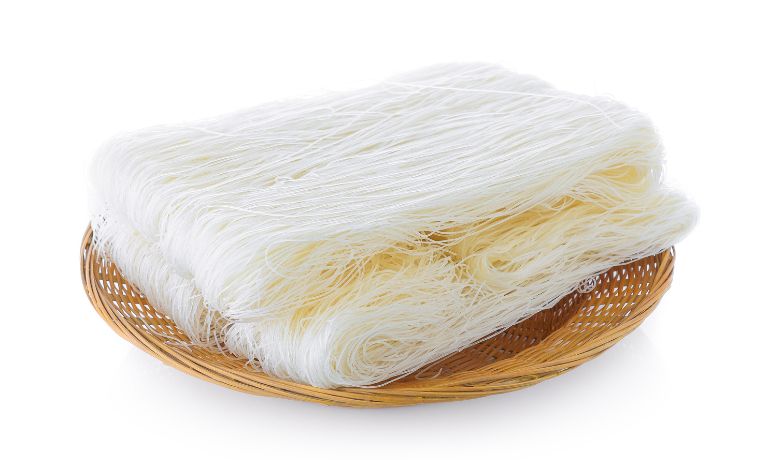
Spaghetti
Spaghetti is Italian pasta made from durum wheat and water, usually cut into long thin strands.
It can be served plain or with sauces or used as an ingredient in many dishes like casseroles, soups, salads, and pasta bakes.
Spaghetti is a great substitute for soba noodles because they have a similar texture and are made from durum wheat.
This makes them an excellent choice for cold noodle salads and stir fry dishes.
Spaghetti is also a great alternative to soba because they come in various shapes and sizes, giving you plenty of options when creating meals.
It can also be cooked quickly and easily, allowing you to enjoy a delicious dinner in no time.
It is incredibly affordable, making them an excellent choice for budget-friendly meals.

Somen Noodles
Somen noodles are thin, white wheat-flour noodles that originated in China.
They are similar to soba noodles because they’re thin and made from flour.
[display-posts id=”2223″ image_size=”thumbnail” posts_per_page=”1″]
However, their smaller size makes somen noodles cook faster than soba noodles.
This makes them a great substitute for soba in cold noodle salads, stir-fried noodles, or hot soup noodles.
They also take on the flavor of whatever ingredients they are cooked with, making them versatile and flavorful ingredients for many different dishes.
The thin texture of somen noodles makes them perfect for light summer meals and hearty winter dishes.
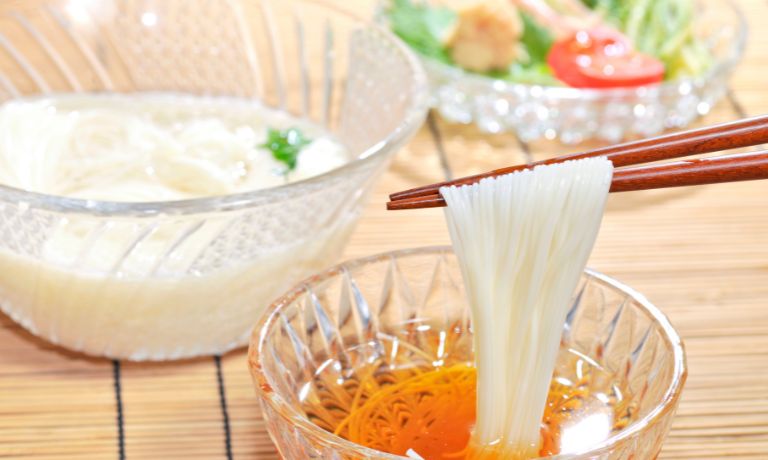
Vermicelli Noodles
Vermicelli noodles are pasta types with thin, round strands similar to angel hair spaghetti.
They can be made from different types of flour, such as wheat or rice, and come in various sizes depending on the dish they’re used for.
Vermicelli noodles can be an excellent alternative to soba noodles in cooking due to their neutral flavor and ability to absorb sauces.
They are also generally less expensive than soba noodles, making them a good budget-friendly option for cooks.
Additionally, vermicelli noodles cook much faster than soba noodles, which can be a timesaver in the kitchen.
Despite their similarities in appearance, vermicelli noodles are not the same as soba noodles.
Soba noodles are made from buckwheat flour and have a nuttier, more distinct flavor than vermicelli.
However, both types of pasta make tasty additions to soups, salads, stir-fries, and other dishes.
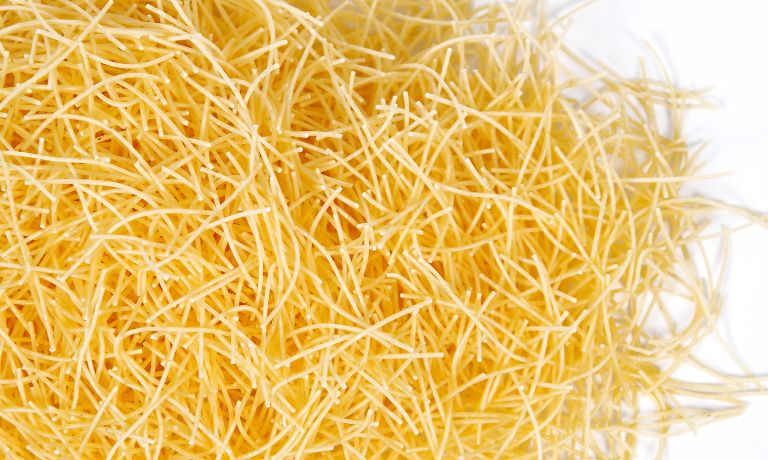
Cellophane Noodles
Cellophane noodles, also known as glass noodles or clear noodles, are an ingredient made from starch (such as mung bean, potato, tapioca or rice).
The noodle is translucent after cooking and has a chewy texture. It can be used in soups, salads and stir-fries, making it a popular meal choice.
[display-posts id=”3020″ image_size=”thumbnail” posts_per_page=”1″]
Cellophane noodles are a great substitute for soba noodles if you’re looking for a healthier option since they’re light and low in calories.
They also have a longer shelf life than traditional soba noodles, making them easier to store and transport.
When cooked properly, cellophane noodles absorb the flavors of whatever dish they’re cooked in, making them a great way to add texture and flavor to your meals.
They are also gluten-free, which makes them an excellent choice for people with intolerances or allergies.
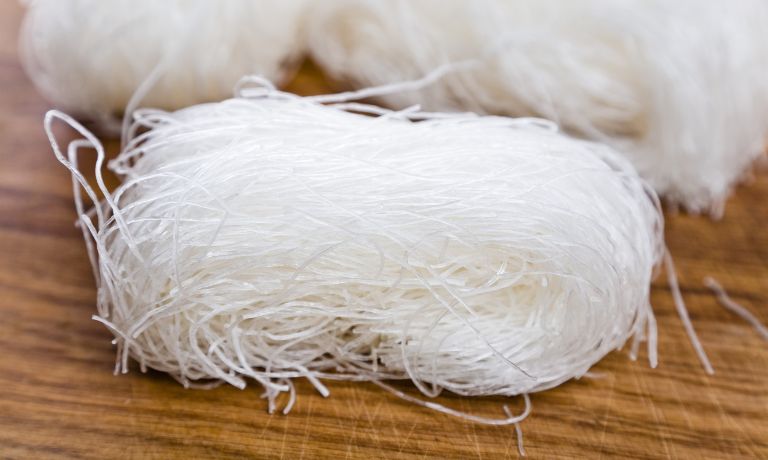
FAQs
Can You Substitute Ramen Noodles For Soba Noodles?
Yes, you can substitute ramen noodles for soba noodles in most recipes.
However, the texture and flavor of the dish will be different since soba noodles have a more robust nutty flavor and firmer texture than ramen noodles.
Can You Substitute Udon Noodles For Soba Noodles?
Yes, you can substitute udon noodles for soba noodles in most recipes.
Udon noodles are thicker and chewier than soba noodles, but they will still work well in many dishes.
Be sure to adjust cooking times accordingly when using udon instead of soba.
Which Noodles Are Gluten-Free?
The majority of noodles are made from wheat, which contains gluten.
However, brands of rice noodles and cellophane noodles do not contain gluten and can be safely enjoyed by those with intolerance or celiac disease.
Quinoa-based noodles are also available as a gluten-free option.
Additionally, many Asian stores carry shirataki noodles made from a vegetable called konjac, which are gluten-free and low in calories.
Are Noodles Healthy?
Noodles can be a healthy part of your diet, depending on the type of noodles you choose and how you prepare them.
Whole-grain or quinoa-based noodles offer more fiber and vitamins than traditional wheat noodles, while cellophane noodles provide fewer calories and carbohydrates.
Conclusion
No matter what type of noodle you’re looking for, there is likely a great substitute for soba noodles.
From rice to vermicelli and cellophane noodles, the options for finding a tasty and healthy alternative to soba noodles are endless.
These substitutes can be used in various dishes, from soups and salads to stir-fries and even pasta bakes.
Experimenting with different types of noodles can be fun and rewarding, so don’t be afraid to try something new and find your perfect substitutes for soba noodles!

